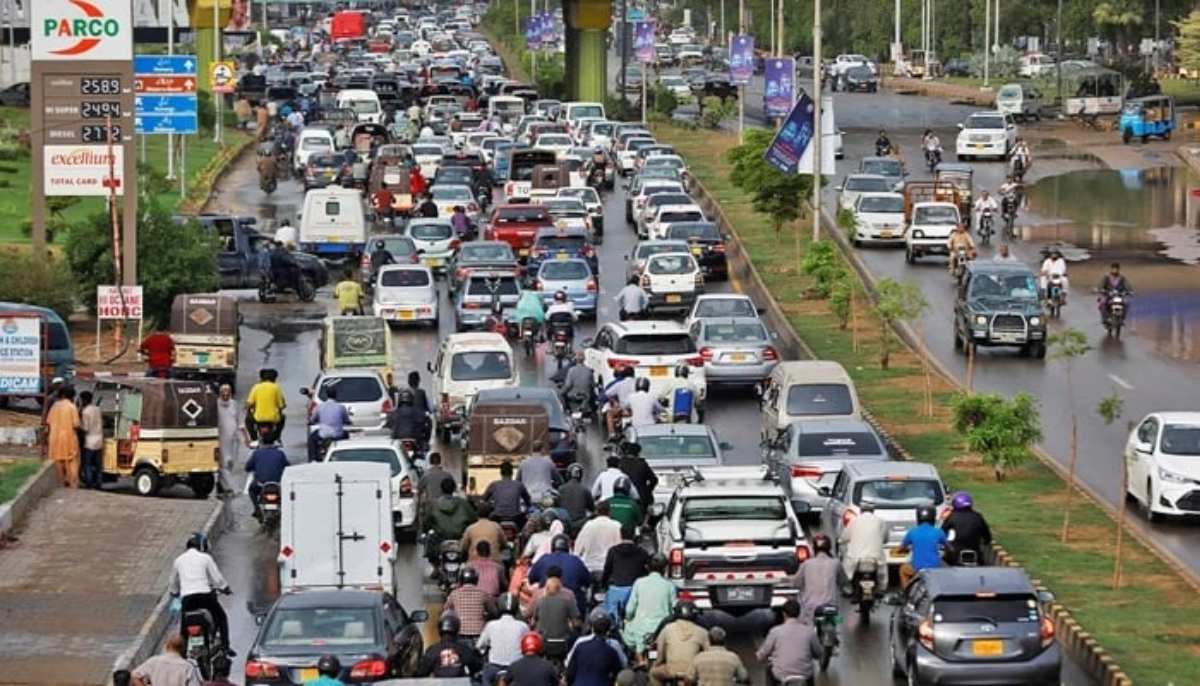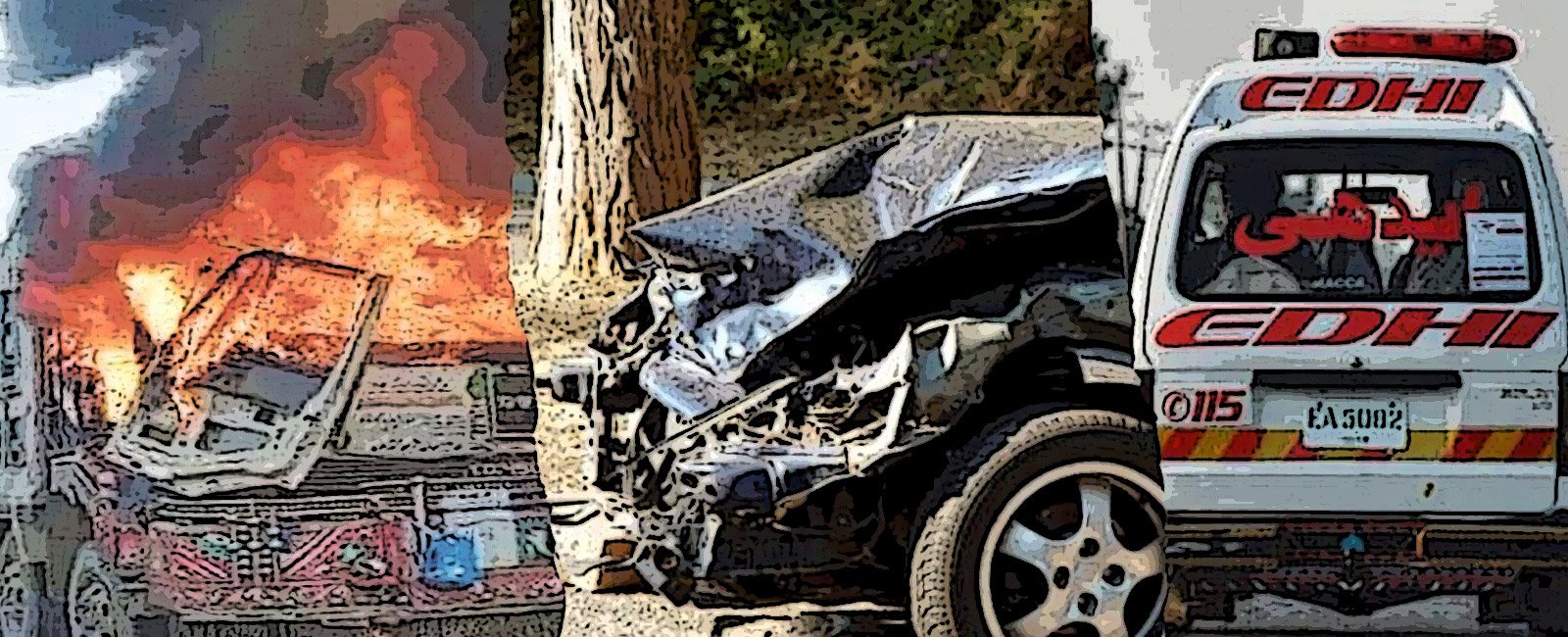Can roads be designed to kill? Navigating the human cost of Karachi's clogged arteries
Edhi data shows that around 279 individuals, including over 40 children and minors, have lost their lives from Jan-April in Karachi accidents this year

Karachi, a city that never sleeps, conjures images of bustling streets and crowds of diverse cultures and aspirations. Yet, just beneath the surface of this sprawling metropolis lies the grim reality of a city hostile to its residents. Choked by unchecked motorisation and rendered unnavigable by an infrastructure that is either human-unfriendly or nearly non-existent, the city’s dirty roads are often washed red with the blood of its people.
In Karachi, it seems the city’s hostile roads lie in wait to make a kill — trucks trampling children, cars crushing motorcyclists, and drivers fleeing the scene are no longer news.
Last month, a truck driver, recklessly driving a water tanker, collided with a couple riding a motorcycle. The pregnant woman delivered her baby by the roadside, only to succumb to her injuries moments later. The newborn also met the same tragic fate. For weeks, the videos and images of that horrifying accident did the rounds on social media.
On April 9, another water truck ran over a biker in North Karachi, sparking public outrage. At least ten water tankers and dumpers were set on fire in the city by angry mobs. The government started arresting the arsonists using video identification, while the drivers who were responsible for the hit-and-run incidents ran scot-free.
In another incident on April 25, a car was sandwiched between a cash-carrying armoured vehicle and a funerary bus. As per an eyewitness account, the chances of survival from that crash seemed very low.
Edhi data shows that around 279 individuals, including more than 41 children and minors, have lost their lives from January to April 2025. Of these 29.39% fatalities, or 82 individuals, were killed by heavy vehicles, including tankers, buses, dumpers, etc. Around 2,263 individuals have been injured, according to only Edhi ambulance data. The majority of the victims in fatal and non-fatal accidents are male, which is in line with global RTA incidents.
Amidst this chaos, the state’s response has been deafeningly silent, devoid of concrete measures to prevent such horrors from happening every day. And sadly, this inaction is understandable. Decades of lopsided urban development and inefficient public transportation policies have spurred the prioritisation of relentless motorisation. Easy access to leasing opportunities has added to these woes. Thus, creating a deeply entrenched problem that is difficult to undo overnight.
Pakistan Bureau of Statistics yearbook 2022 data shows that motorcycle registration in the country increased from 55% in 2010 to 76% in 2020, whereas registration of buses declined from 2.5% to 0.83%.
According to Yousuf Iqbal, senior director at Karachi Development Authority's (KDA) Traffic Engineering Department, motorcyclists account for 70% of road fatalities, while pedestrians comprise 28%.
Highlighting the city’s traffic composition, he said two-wheelers made up 62% and four-wheelers 28% of vehicles on Karachi’s roads — a mix that has increased traffic conflicts.
“Designing dedicated lines for each traffic type can help reduce accidents between different vehicles,” Iqbal said, when asked about the current conflict between motorcyclists, pedestrians, and truckers.
Research has demonstrated a strong correlation between the persistent lack of pedestrian-friendly infrastructure and public transportation, with the continuous and rapid increase in private vehicle ownership and the rate of fatalities caused by road traffic accidents (RTA).
The ratio of public transportation in Karachi is very low, and to deal with that, people rely on private vehicles more and more.
“There is a need to complete public transportation projects on a war footing. The Red Line Project will now take an additional 2-3 years to complete,” Iqbal said, lamenting the slow progress of government transportation projects.
Although the Sindh government’s People’s Bus Service, connected to the Bus Rapid Transit (BRT) system, is trying to resolve the public transportation issue, the slow pace of these projects and limited capacity are significant drawbacks in a city on the scale of Karachi.
The two active BRT lines currently cater to a small fraction of the city’s vast population, leaving the majority to rely on inadequate, inefficient, and unreliable alternatives like Qingqis, traditional rickshaws, ride-hailing apps, and personal vehicles, particularly motorcycles.
Urban dysfunction and motorcycles
A 64-year-old motorcyclist, Hassan Ali, in Karachi suffered a seemingly minor neck injury after hitting a pothole. But within three days, that injury turned serious, and he experienced paralysis, prompting urgent hospitalisation, his niece Amina Mahboob shared. Ali was diagnosed with a severely pinched nerve in his cervical spine. Doctors suggested surgery with a warning that the recovery would be very slow. “My uncle is recovering now, but the process is very slow. He can move his fingers and toes, and slightly move his arms too. The government must fix the broken roads all over Karachi,” she said.
In another incident, a 32-year-old man was rushed to the hospital by his friend, who had found him unconscious in his neighbourhood in North Karachi Sector 11. The man suffered a severe concussion after falling from his motorcycle, which had struck a pothole. He was kept in the ICU for three days. He is now recovering at home, albeit slowly, his sister, who wishes to remain anonymous, shared.

On the run-down road conditions, the KDA official admitted, “Karachi is in dire straits. It is not that funds are insufficient; the issues are distribution and vested interests.”
Incidents like these show that the potholes on the streets of Karachi, which have been the butt of many jokes, are no laughing matter. Neither incident was reported to the police or rescue services. Both victims of this urban dysfunction were treated at private hospitals.
Reporting disparities
Unrecorded accidents also underscore the matter of reporting disparities. Accurately reporting the numbers would help identify the needed interventions. Investigation shows a huge gap between the data recorded by the rescue services and by the police department, which becomes part of the overall numbers maintained and published by the Pakistan Bureau of Statistics (PBS). The police data only shows the First Information Reports (FIR), and therefore does not portray the absolute numbers of deaths and injuries due to RTAs.
Muhammad Amin, In-charge Edhi Ambulance Control Room Karachi, said the data maintained by the Edhi Foundation was obtained from three public sector trauma centres, JPMC, Civil Hospital Karachi, and the Abbasi Shaheed Hospital, and the ambulance network.
The Edhi Foundation data reveals a high number of accidents involving "unknown vehicles" (123 fatalities), 82 involving heavy vehicles such as trailers, dumpers, trucks, etc, and 25 involving cars and jeeps.
This issue is further exacerbated by the significant lack of vehicle type information within police records, which has severe long-term repercussions for effective policy and safety interventions. What is even more concerning is that this absence of comprehensive data with the police is because people are afraid of going through the legal hassles that accompany the filing of an FIR.
"Edhi data does not have the record of victims who reach the hospital via their own or other means. Many minor injuries do not even get reported," Amin added.
A city government official stated that the government relied on police data, despite experts advocating that accident data collection should fall under the purview of municipal bodies like the KDA's Traffic Engineering Department. This debate had also risen when Pakistan’s only research centre, “Road Traffic Injury Research and Prevention Centre (RTIR&PC)” at the JPMC, shut down in December 2016. Experts back then had pointed out that the city government was responsible for collecting the RTA data, not the traffic police, as they were law enforcers and wouldn't be able to collect data impartially.
KDA's Iqbal said that the Traffic Engineering Department did not have funds to do so. “Many of the important seats at the department are lying vacant,” he informed.
Without comprehensive data and a detailed evaluation of factors contributing to traffic accidents, including spatial characteristics, vehicle-oriented planning policies, poor engineering and educational interventions, and poor law enforcement, the government resorts to ad hoc measures for reducing RTAs.
“We have recently intervened at the Sohrab Goth roundabout because of 3-4 hours traffic jams. Now the traffic is running smoothly on the highway,” Iqbal said. However, motorcyclists are now just jumping over the barriers to avoid a 10km u-turn so they can get to Abul Hasan Isfahani Road faster.
RTAs are preventable, and if correct planning and design decisions are taken by the policy and decision-makers by putting people in the policy, the number of fatal and non-fatal injuries can be drastically reduced. The assessment of the relationship between fatalities in RTAs, poor walkability, and lack of adequate public transport can help planners and decision-makers to improve road safety for all users.
Andaleeb Rizvi is a journalist based in Karachi and a former staffer at The News.
Header and thumbnail illustration by Geo.tv




